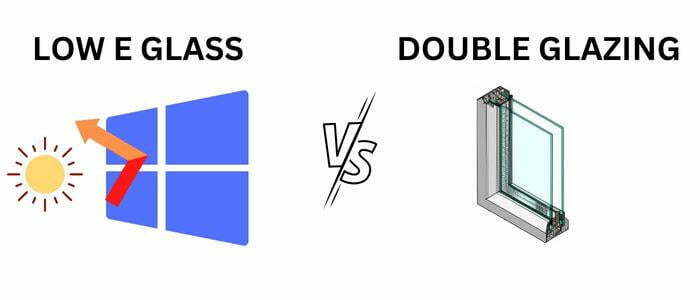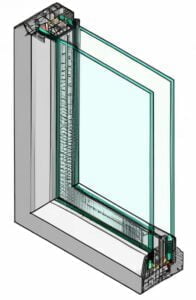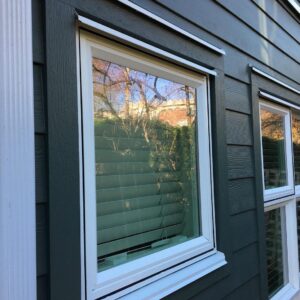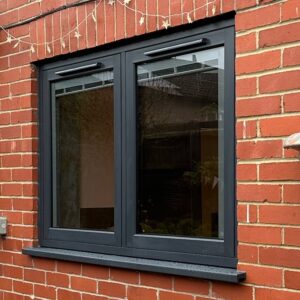Low E Glass vs Double Glazing: Which is Better?
Low-E glass and double glazing are two types of energy efficient window treatments that have many benefits, from reducing heating and cooling costs to blocking unwanted UV rays from entering your home. But what’s the difference between Low-E glass and double glazing? Let’s take a look.
- Low-E Glass: Offers energy efficiency by reflecting heat while allowing light in, and blocks UV rays, which is beneficial for sunny climates and reducing solar heat gain.
- Double Glazing: Consists of two glass panes with an air gap, providing superior insulation and soundproofing, suitable for colder climates and noise reduction.
- Performance Metrics: U-value measures insulation efficiency, SHGC quantifies solar heat gain, and VLT indicates the amount of visible light that passes through.
- Decision Factors: Choose based on specific needs—Low-E for sun control and Double Glazing for insulation and noise.

Comparison: Low-E Glass vs Double Glazing
| Feature | Low-E Glass | Double Glazing |
|---|---|---|
| Energy Efficiency | High (reflects heat, allows light) | Very High (insulates against heat loss/gain) |
| Cost | Varies | Typically higher than Low-E |
| Noise Insulation | Moderate | High (due to air gap) |
| UV Blocking | High | Moderate |
| Suitability for Climates | Sunny, moderate climates | Colder, variable climates |

What is Low E Glass?
Low-E glass, or low emissivity glass, is a type of specially coated window pane designed to reflect heat while allowing visible light through—essentially helping you save on energy costs without sacrificing natural daylight. It also helps block out damaging UV rays which can cause damage to furniture and fading of fabrics. Low-E coatings come in a variety of forms, but all are designed to maximize the amount of natural light coming in while minimizing heat loss in winter or gain in summer.

What is Double Glazing?
Double glazing consists of two panes of glass with an air gap between them in order to increase the insulation value of your windows. This air gap not only reduces heat transfer more effectively than single pane windows, but also minimizes sound transmission into the home for improved comfort levels inside. It’s important to note that the width of this air gap plays an important role in its effectiveness as it determines how much insulation is provided.
SGHC, Visible Transmission, U-value?
U-Value (Thermal Transmittance): This measures how well a window can prevent heat from escaping. It’s a calculation of the rate of heat transfer through a window system. The lower the U-value, the better the material is as a heat insulator. In simple terms, a window with a low U-value will keep heat inside a building on a cold day more effectively.
SHGC (Solar Heat Gain Coefficient): SHGC indicates how much of the sun’s energy striking the window is transmitted as heat into the home. The lower the SHGC, the better the glass is at blocking heat caused by sunlight. Glass with a low SHGC is more effective at reducing cooling loads during hot weather by blocking heat gain from the sun.
VLT (Visible Light Transmission): This measures the amount of visible light that passes through the glass. It is expressed as a percentage, with higher numbers indicating more light passing through. A high VLT is usually desired to maximize daylight and visibility, but in some cases, a lower VLT may be preferred to reduce glare or for privacy reasons.
These values are essential in choosing the right type of glass for energy efficiency, comfort, and the intended use of a space. Each value has implications on the thermal and visual comfort of the building’s occupants and can impact energy costs related to heating and cooling.
| Type | U-Value | SHGC | VLT |
|---|---|---|---|
| Clear | 3.6 | 0.69 | 82 |
| Green | 3.6 | 0.51 | 71 |
| Neutral | 3.6 | 0.52 | 59 |
| Light Grey | 3.6 | 0.56 | 54 |
| Bronze | 3.6 | 0.53 | 49 |
| Grey | 3.6 | 0.50 | 39 |
| Translucent | 3.6 | 0.59 | 63 |
So Which is Better? Double glazing or low E glass?
| Performance Metric | Low-E Glass | Double Glazing | Best Use Case |
|---|---|---|---|
| U-Value (Thermal Transmittance) | Lower U-value, better at preventing heat escape. | Very low U-value, superior insulation. | Cold Climates: Double Glazing excels in retaining indoor heat. |
| SHGC (Solar Heat Gain Coefficient) | Lower SHGC, excellent at reducing solar heat gain. | Moderate SHGC, less effective in solar control. | Warm & Sunny Climates: Low-E Glass is preferable for minimizing heat entry. |
| VLT (Visible Light Transmission) | High VLT, allows more natural light. | Good VLT, slightly less natural light than Low-E Glass. | Mixed Climates: Low-E Glass for brighter illumination without extra heat. |
| Environmental Adaptability | Ideal for sunny, warm climates due to heat reflecting properties. | Best for colder climates, where heat retention is crucial. | Variable Climates: Consider combining both for year-round efficiency. |
Real World Examples
Sarah Thompson from Bondi Beach: Sarah was looking to replace her home’s windows to combat the intense sunlight and occasional chilly winds. After consulting with us, she chose Low-E glass. The primary reason was its ability to reflect heat while allowing ample natural light, perfect for her sunlit home. We didn’t advise Sarah to go for double glazing because, in her specific location, the primary concern was the sun’s intensity rather than insulation from cold, making Low-E glass a more suitable choice.

James and Lisa Mitchell from Parramatta: The Mitchells were keen on reducing both their energy bills and the noise from the streets. They opted for double glazing after our recommendation. The air gap in double glazed windows not only provided them with excellent insulation against varying temperatures but also significantly reduced the noise intrusion. While Low-E glass could have offered some energy efficiency, it wouldn’t have addressed their noise concern as effectively as double glazing did.

Amelia Rodriguez from Manly: Amelia’s sea-facing apartment in Manly often faced the brunt of salty sea winds, leading to rapid cooling in the evenings. She was inclined towards Low-E glass, but after our assessment, we recommended double glazing. The reason was its superior insulation properties, ensuring her home remained warm during cooler evenings. We believed that while Low-E glass would have been beneficial against the sun’s rays, it wouldn’t have provided the same level of insulation against the cold sea winds as double glazing.
Raj and Priya Kapoor from Chatswood: Living in a high-rise in Chatswood, the Kapoors were battling with both the summer heat and the glare from surrounding buildings. They decided on Low-E glass after our consultation. The special coating on Low-E glass helped in reflecting the heat and reducing the glare, making their living space much more comfortable. Double glazing, in their case, might have provided insulation, but it wouldn’t have been as effective in dealing with the specific challenges of heat and glare they faced.

Phillip Sharp has spent more than three decades honing his skills as a glazier in Sydney. He is currently employed at Splendid Window Glass Repairs, where he specializes in glass replacement and repair in the Sydney Eastern Suburbs area. With his wealth of experience and commitment to excellent craftsmanship, Phillip is highly respected in the industry and trusted by clients to provide top-quality work.
